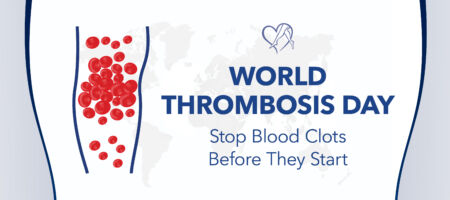
Every October 13, people around the world observe World Thrombosis Day. The goal is simple yet urgent: to bring attention to a health threat that’s often overlooked, that is, thrombosis, or blood clots. Despite being a leading cause of death and disability, many don’t realize how common clots are, how dangerous they can be, or how much can be done to prevent them.

Thrombosis is the formation of a blood clot within a blood vessel of the veins, arteries, heart chambers, or kidneys, which blocks blood flow to vital organs. When a clot forms in a deep vein, typically in the leg, it is referred to as deep vein thrombosis (DVT). If a piece of that clot breaks loose and travels to the lungs, it becomes a pulmonary embolism (PE), which can be fatal. Together, DVT and PE are collectively referred to as venous thromboembolism (VTE).
Worldwide, one in four people dies from conditions related to thrombosis, according to the World Thrombosis Day organization. That statistic is staggering. Among cardiovascular causes of death, thrombosis underlies three of the leading killers: heart attack, stroke, and VTE.
According to the Centers for Disease Control (CDC), each year, as many as 900,000 Americans develop venous thromboembolism (VTE)—a blood clot that forms in a vein. The risk rises significantly during or shortly after a hospital stay, cancer treatment, or pregnancy. Tragically, between 60,000 and 100,000 people in the U.S. die from VTE annually, and many more live with lasting complications.
Despite these startling statistics, awareness is low, and many people are unaware of the warning signs or risk factors. According to World Thrombosis Day’s own information, even within health systems, gaps in prevention, diagnosis, and treatment remain.
World Thrombosis Day reminds us that awareness saves lives, but taking a proactive approach to vein disease can also protect lives. If you have varicose veins, swelling, or leg heaviness or discomfort, these symptoms may indicate vein disease that increases your risk of blood clots.
Trust the board-certified specialists at Center for Vein Restoration to diagnose and treat the root causes of thrombosis. Schedule your consultation today and take a proactive step toward preventing clots before they start.
📞 Call Center for Vein Restoration at 240-965-3915
📅 Or book online HERE
The International Society on Thrombosis and Haemostasis (ISTH) launched World Thrombosis Day in 2014 to raise awareness about thrombosis, transforming it from an invisible condition to one that is urgent. WTD now operates year-round, offering tools, educational resources, and campaigns to promote awareness in everyday health practices.
October 13 was chosen because it is the birthday of Rudolf Virchow, a scientist who first explained many mechanisms behind thrombosis. In just its first year, more than 175 organizations globally participated in WTD. Over time, the campaign has introduced strategic pillars to improve research, deepen partner engagement, broaden translated content, and strengthen media outreach.
In 2025, the World Thrombosis Day theme is “From Head to Toe, Take Control: Prevent Thrombosis, Protect Your Health.” The message is that clots can form anywhere, including the brain, legs, lungs, or arms, and emphasizes the need for a full-body approach.
Blood clots don’t happen in isolation; they often stem from underlying chronic venous insufficiency (CVI), a condition in which weakened vein valves cause blood to pool in the legs. Center for Vein Restoration (CVR) is the nation’s largest physician-led vein practice, specializing in the early detection and treatment of venous disease before it leads to dangerous complications such as deep vein thrombosis (DVT).
With more than 120 locations nationwide and a 98 percent patient satisfaction rate, CVR’s board-certified vein specialists are the trusted experts in keeping your blood flow healthy and your risks low.

Because thrombosis is often associated with many chronic conditions, it can go undetected. Some key risk factors:
According to a World Thrombosis Day study, “only 28 percent of respondents said they would know what a blood clot in the leg would feel like,” making it important to educate family and friends about DVTs.
Signs and symptoms can vary, but here are a few to watch for:
If any of these occur, urgent medical attention is needed.
If you notice symptoms that could indicate deep vein thrombosis (DVT), seek medical care right away because DVT can become a serious emergency. Center for Vein Restoration offers a same-day DVT rule-out service with on-site imaging, treatment, and follow-up care. Call 877-SCAN-DVT (877-722-6388) for immediate evaluation.
When it comes to preventing or diagnosing clots, especially those involving the veins, seeing a board-certified vein specialist (or vascular surgeon with specialization in venous disease) can be a crucial step. Here’s why:
At Center for Vein Restoration, our team of compassionate, board-certified vein specialists is well prepared to evaluate your vein health and clot risk.
Thrombosis is a silent but pervasive health threat. Though it contributes to one in four deaths globally, it often escapes public attention.
On October 13 (and every day!), protect your health by using these tips:
Take control of your vein health today and find your nearest CVR clinic and consult with the country’s leading vein care experts.
